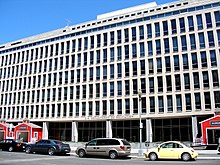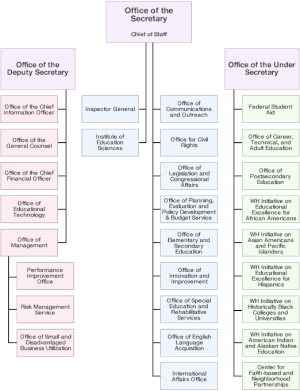User:Nickapplewhite/sandbox
 Seal of the U.S. Department of Education | |
 Flag of the U.S. Department of Education | |
 The Lyndon Baines Johnson Department of Education building | |
| Department overview | |
|---|---|
| Preceding agencies |
|
| Jurisdiction | Federal government of the United States |
| Headquarters | 400 Maryland Avenue SW, Washington, D.C. 38°53′11.45″N 77°1′7.86″W / 38.8865139°N 77.0188500°W |
| Employees | 5,000 (2007) |
| Annual budget | US$32 billion (2009)[1] US$56 billion (est. 2010) US$71 billion (est. 2011) US$68.1 billion (2012) US$69.8 billion (2013) ARRA Funding: US$102 billion (2009)[1] US$51 billion (est. 2010) US$23 billion (est. 2011) US $19.4 billion (2012) |
| Department executives | |
| Child Department | |
| Website | www.ed.gov |
The United States Department of Education (ED or DoED), also referred to as the ED for (the) Education Department, is a Cabinet-level department of the United States government. Recreated by the Department of Education Organization Act (Public Law 96-88) and signed into law by President Jimmy Carter on October 17, 1979, it began operating on May 4, 1980.[2]
The Department of Education Organization Act divided the Department of Health, Education, and Welfare into the Department of Education and the Department of Health and Human Services. The Department of Education is administered by the United States Secretary of Education. It is by far the smallest Cabinet-level department, with about 5,000 employees.
History
[edit]A previous Department of Education was created in 1867 but was soon demoted to an Office in 1868.[3][4] As an agency not represented in the president's cabinet, it quickly became a relatively minor bureau in the Department of the Interior. In 1939, the bureau was transferred to the Federal Security Agency, where it was renamed the Office of Education. In 1953, the Federal Security Agency was upgraded to cabinet-level status as the Department of Health, Education, and Welfare.
In 1979, President Carter advocated for creating a cabinet-level Department of Education.[5] Carter's plan was to transfer most of the Department of Health, Education, and Welfare's education-related functions to the Department of Education.[5] Carter also planned to transfer the education-related functions of the departments of Defense, Justice, Housing and Urban Development, and Agriculture, as well as a few other federal entities.[5] Among the federal education-related programs that were not proposed to be transferred were Headstart, the Department of Agriculture's school lunch and nutrition programs, the Department of the Interior's Indian education programs, and the Department of Labor's education and training programs.[5]
As of 1979, the Office of Education had 3,000 employees and an annual budget of $12 billion.[6] Congress appropriated to the Department of Education an annual budget of $14.2 billion and 17,000 employees when establishing the Department of Education.[7]
On March 23, 2007, President George W. Bush signed into law H.R. 584, which designates the ED Headquarters building as the Lyndon Baines Johnson Department of Education Building.[8]
Functions
[edit]The primary functions of the Department of Education are to "establish policy for, administer and coordinate most federal assistance to education, collect data on US schools, and to enforce federal educational laws regarding privacy and civil rights."[9] The Department of Education does not establish schools or colleges.[10]
The Office of the Inspector General conducts audits and investigation in connection to the Department's programs.
Unlike the systems of most other countries, education in the United States is highly decentralized, and the federal government and Department of Education are not heavily involved in determining curricula or educational standards (with the recent exception of the No Child Left Behind Act). This has been left to state and local school districts. The quality of educational institutions and their degrees is maintained through an informal private process known as accreditation, over which the Department of Education has no direct public jurisdictional control.
The Department's mission is: to promote student achievement and preparation for global competitiveness by fostering educational excellence and ensuring equal access.[11] Aligned with this mission of ensuring equal access to education, the Department of Education is a member of the United States Interagency Council on Homelessness,[12] and works with federal partners to ensure proper education for homeless and runaway youth in the United States.
Organization
[edit]
Controversy
[edit]Major legislation surrounding the Department includes the No Child Left Behind Act. There is a lot of concern regarding the fairness and effectiveness of this bill. Adolescent literacy is in a deep decline, begging a multitude of scrutiny of the law from it's critics. This legislation suggests that greater accountability is to be gained through increased attention to results of annual assessments in grades 3 through 8.[13] Under President George W. Bush, the Department primarily focused on elementary and secondary education, expanding its reach through the No Child Left Behind Act. The Department's budget increased by $14B between 2002 and 2004, from $46B to $60B.[15] To close the achievement gap, NCLB requires that every teacher in America will be "highly qualified" and that every student will be "proficient" in reading and math by the 2013-14 school year - a 100 percent success rate that no government program has ever reached. [14]
Opposition Opposition to the Department of Education mainly stems from conservatives, who see the department as an undermining of states rights, and libertarians who believe it results in a state-imposed leveling towards the bottom and low value for taxpayers' money.[15] The origins of the department are surrounded by controversy as the upgrading of the department to cabinet level status in 1979 was opposed by many in the Republican Party, who saw the department as unconstitutional, arguing that the Constitution doesn't mention education, and deemed it an unnecessary and illegal federal bureaucratic intrusion into local affairs. However many liberals and Democrats see the department as constitutional under the Commerce Clause, and that the funding role of the Department is constitutional under the Taxing and Spending Clause. The National Education Association supported the bill, while the American Federation of Teachers opposed it.[16]
The Republican Party platform of 1980 called for the elimination of the Department of Education created under Carter and President Ronald Reagan promised during the 1980 presidential election to eliminate it as a cabinet post,[17] but he was not able to do so with a Democratic House of Representatives. In the 1982 State of the Union Address, he pledged:
| “ | The budget plan I submit to you on Feb. 8 will realize major savings by dismantling the Department of Education.[18] | ” |
By 1984 the GOP had dropped the call for elimination from its platform, and with the election of President George H. W. Bush the Republican position evolved in almost lockstep with that of the Democrats, with Goals 2000 a virtual joint effort.
After the Newt Gingrich led "revolution" in 1994 had taken control of both Houses of Congress, federal control of and spending on education soared. That trend continued unabated despite the fact that the Republican Party made abolition of the Department a cornerstone of 1996 platform and campaign promises, calling it an inappropriate federal intrusion into local, state, and family affairs.[18] The GOP platform read:
| “ | The Federal government has no constitutional authority to be involved in school curricula or to control jobs in the market place. This is why we will abolish the Department of Education, end federal meddling in our schools, and promote family choice at all levels of learning.[18][19] | ” |
(During his 1996 presidential run, Senator Bob Dole promised, "We're going to cut out the Department of Education."[19]).
In 2000, the Republican Liberty Caucus passed a resolution to abolish the Department of Education.[20]
Abolition of the organization was not pursued under the George W. Bush administration, which made reform of federal education a key priority of the President's first term. In 2008 and 2012, presidential candidate Ron Paul campaigned in part on an opposition to the Department.[21]
Budget
[edit]- 2006: $56 billion. [22]
- 2008: $59 billion.[23]
- 2009: $62.6 billion.[24]
- 2010: $64 billion.[25]
- 2011 the discretionary budget was $69.9 billion.[26]
Related legislation
[edit]- 1965: Elementary and Secondary Education Act (ESEA)
- 1965: Higher Education Act of 1965 (HEA) (Pub. L. No. 89-329)
- 1974: Family Educational Rights and Privacy Act (FERPA)
- 1974: Equal Educational Opportunities Act of 1974 (EEOA)
- 1975: Education for All Handicapped Children Act (EHA) (Pub. L. No. 94-142)
- 1978: Protection of Pupil Rights Amendment
- 1980: Department of Education Organization Act (Pub. L. No. 96-88)
- 1984: Equal Access Act
- 1990: The Jeanne Clery Disclosure of Campus Security Policy and Campus Crime Statistics Act (Clery Act)
- 1994: Improving America's Schools Act of 1994
- 2001: No Child Left Behind Act (NCLB)
- 2004: Individuals with Disabilities Education Act (IDEA)
- 2005: Higher Education Reconciliation Act of 2005 (HERA) (Pub. L. No. 109-171)
- 2006: Carl D. Perkins Career and Technical Education Improvement Act
- 2007: America COMPETES Act
- 2008: Higher Education Opportunity Act (HEOA) (Pub. L. No. 110-315)
- 2009: Race to the Top
- 2009: Student Aid and Fiscal Responsibility Act
- 2010: Health Care and Education Reconciliation Act of 2010
See also
[edit]- Council for Higher Education Accreditation
- Education in the United States
- Educational attainment in the United States
- Free Application for Federal Student Aid
- National Diffusion Network
- Federal Student Aid
- School Improvement Grant
- United States Secretary of Education
Notes and references
[edit]- ^ a b FY2011 Federal Budget
- ^ Department of Education Organization Act As Enacted
- ^ Department of Education Act of 1867 As Enacted
- ^ Chap. CLVIII. 14 Stat. 434 from "A Century of Lawmaking for a New Nation: U. S. Congressional Documents and Debates, 1774–1875". Library of Congress, Law Library of Congress. Retrieved April 25, 2012.
- ^ a b c d "Department of Education Outlined". Pittsburgh Post-Gazette, via Google News. Associated Press. February 9, 1979.
- ^ Hechinger, Fred M (September 3, 1979). "Federal Education Branch Is Foundering, Leaderless". Lexington, North Carolina: The Dispatch, via Google News. New York Times News Service.
- ^ "Education Department Created". The Palm Beach Post, via Google News. United Press International. October 18, 1979.
- ^ "President Bush Signs H.R. 584, Designates U.S. Department of Education as the Lyndon Baines Johnson Federal Building". Georgewbush-whitehouse.archives.gov. 2007-03-23. Retrieved 2012-08-25.
- ^ What We Do. ED.gov. Retrieved on 2013-07-17.
- ^ "An Overview of the U.S. Department of Education- Pg 2". United States Department of Education. Retrieved August 25, 2012.
- ^ "An Overview of the U.S. Department of Education- Pg 1". United States Department of Education. Retrieved August 25, 2012.
- ^ "Department of Education | Member Agency | United States Interagency Council on Homelessness (USICH)". Usich.gov. Retrieved 2012-08-25.
- ^ Conley, Mark (2004). "No Child Left Behind: What it means for U.S. adolescents and what we can do about it". Journal of Adolescent & Adult Literacy. 48 (1): 43. doi:10.1598/JAAL.48.1.4.
{{cite journal}}:|access-date=requires|url=(help) - ^ Ferguson, A. "No Child Left Alone". The Weekly Standard.
- ^ "Laissez-faire-learning". Retrieved 2012-06-28.
- ^ "House Narrowly Passes Department of Education Bill". Spokane, Washington: The Spokesman-Review, via Google News. The New York Times. July 12, 1979.
- ^ "Online Backgrounders: The Department of Education". PBS. Fall 1996. Retrieved 2005-07-26.
{{cite web}}: Italic or bold markup not allowed in:|publisher=(help) - ^ a b c "Elimination Lost: What happened to abolishing the Department of Education?". Cato Institute. 2004-02-11. Retrieved March 7, 2014.
{{cite web}}: Italic or bold markup not allowed in:|publisher=(help) - ^ a b "Department of Education must be abolished". World Net Daily. 2004-12-07. Retrieved 2005-07-26.
{{cite web}}: Italic or bold markup not allowed in:|publisher=(help) - ^ "Education". 2007. Retrieved 2007-09-14.
- ^ Stossel, John (2007-12-10). "Ron Paul Unplugged". ABC News. Retrieved 2008-01-30.
- ^ "Overview". U.S. Department of Education Budget Office. 2011-02-12. Retrieved 2011-03-27.
- ^ "THE BUDGET AND POLICY PROPOSALS OF THE U.S. DEPARTMENT OF EDUCATION". GPO. COMMITTEE ON EDUCATION AND THE WORKFORCE U.S. HOUSE OF REPRESENTATIVES.
- ^ "THE BUDGET AND POLICY PROPOSALS OF THE U.S. DEPARTMENT OF EDUCATION". GPO. COMMITTEE ON EDUCATION AND THE WORKFORCE U.S. HOUSE OF REPRESENTATIVES.
- ^ "THE BUDGET AND POLICY PROPOSALS OF THE U.S. DEPARTMENT OF EDUCATION". GPO. COMMITTEE ON EDUCATION AND THE WORKFORCE U.S. HOUSE OF REPRESENTATIVES.
- ^ "Overview". U.S. Department of Education Budget Office. 2011-02-12. Retrieved 2011-03-27.
Further reading
[edit]- Radin, Beryl A., and Willis D. Hawley. Politics of Federal Reorganization: Creating the U.S. Department of Education (1988)
External links
[edit]- United States Department of Education Official Website
- Department of Education in the Federal Register
- How is the Department of Education Organized
- ERIC Digests – Informational digests on educational topics produced by the U.S. Department of Education before 1983.
Category:Government agencies established in 1979 Education Department Of Education Category:Education ministries


